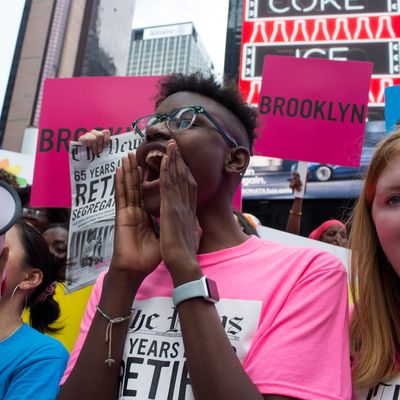
Photograph: Andrew Lichtenstein/Corbis through Getty Pictures
The seventieth anniversary of the Supreme Courtroom’s Brown v. Board of Schooling determination, which outlawed racial segregation in public faculties, got here and went in New York with little official discover. Maybe our leaders have been embarrassed by the truth that our metropolis has been cited for greater than a decade as having the nation’s most racially segregated faculties and has achieved little or nothing to implement dozens of cheap proposals to maneuver within the course of integration.
“We now have the define, we’ve the blueprint. Integration is possible. It’s inside our attain,” says Nyah Berg, the manager director of New York Appleseed, a nonprofit group that advocates for built-in faculties across the state. I not too long ago sat down with Berg and Matt Gonzales, who works on the Metropolitan Middle for Analysis on Fairness and the Transformation of Colleges, a division of NYU’s graduate faculty of schooling. They’re a part of a rising motion of younger researchers and advocates who’re fed up with New York’s delays and dissembling on range.
“You may’t repair segregation by creating extra segregated Stuyvesants, extra segregated gifted-and-talented packages. In the end, what we’ve all the time advocated for is that each one college students in New York Metropolis deserve high-quality, numerous, and equitable faculties,” Gonzales instructed me. “There are a lot of insurance policies sitting on the desk, actually accumulating mud, that may be applied to lower segregation in New York Metropolis faculties.”
It’s straightforward to overlook the segregation that stains and divides our cosmopolitan metropolis. Sure, all of us hear the wonderful cacophony of the a number of languages spoken within the streets and subways, however New York has lengthy tolerated, instituted, and defended practices — from forcing 4-year-olds to take standardized checks to requiring face-to-face screening interviews as a situation of admission to fascinating faculties — that inexorably kind college students into racial enclaves.
The separation is blatantly seen on maps revealed at integratenyc. The 40 faculties in Manhattan’s District 3, as an example, have a complete enrollment of simply over 14,000 college students, of which roughly 27 % are white, 24 % Black, 35 % Latino, and eight % Asian. It is a zone that features the West Facet and a part of Central Harlem, working from 59th Avenue to 122nd Avenue. However practically a dozen of the faculties are largely white and Asian, with solely a smattering of Black college students, whereas at the least 13 faculties are greater than 90 % Black and Latino.
“Primarily all college students of coloration attend predominantly nonwhite faculties, whereas two-thirds of white college students do the identical,” a research of New York faculties by the UCLA Civil Rights Mission present in 2021. “Roughly 85 % of Black college students, and three-fourths of Latino college students, attend intensely segregated faculties, whereas solely 11 % of white and 43 % of Asian college students do.
There isn’t a excuse for permitting our youngsters to develop up in mini-monocultures, subtly selling the lie that “these folks” are basically worse or much less deserving than their fellow New Yorkers.
“I’ve labored on these and associated points for a half-century, and I’ve by no means seen a faculty district that was separate and equal,” Gary Orfield of UCLA wrote within the ahead to his 2021 report. “When I’ve been testifying in a civil-rights case, I’ve requested consultants on the opposite facet to inform me the place there’s one however have by no means obtained a solution.”
A Faculty Variety Advisory Group, assembled by Mayor Invoice de Blasio in 2017, revealed a well-received report on the necessity for desegregation. However the group’s second plan, which known as for altering or ending using screening interviews and checks, obtained a cold reception. “The second report had about 30 suggestions, and that basically was the enamel to those targets. How have been we going to essentially desegregate?” Berg stated. “And that was met with silence.”
For many years, underneath the Bloomberg and de Blasio administrations, Metropolis Corridor tended to mischaracterize the problem as a shortage drawback, as if segregation have been a pure final result as a result of high-performing faculties are like a well-liked restaurant or scorching dance membership — a rarefied non-public house that, by definition, is offered solely to a lucky few. That velvet-rope method was soundly rejected by Teenagers Take Cost, a grassroots group of younger folks that staged a string of walkouts and protests in help of integration shortly earlier than the COVID pandemic struck.
A number of the suggestions did get pushed by way of, like ending the follow of testing 4-year-olds for admission to gifted-and-talented packages and suspending necessities for face-to-face entrance interviews, due to the pandemic. “We really couldn’t use check scores and absences and different [measures] for a middle-school admissions coverage as a result of we have been underneath a world pandemic,” Gonzales instructed me. “However as quickly because the Adams administration got here into play, they began reversing a lot of these insurance policies. A number of the responses we’ve heard from the Adams administration is that they will’t appropriate generational segregation. And we perceive that there’s a variety of work to do, however they’ve really doubled down on many insurance policies that we’ve recognized for a few years contribute to and improve segregation in New York Metropolis faculties.”
We might have one other spherical of grass-roots effort to restart New York’s desegregation motion. “There are reams and reams of social-science analysis that confirmed that built-in faculties are good faculties,” Berg instructed me. “Colleges must be built-in to be good. And that’s as a result of it exhibits will increase in tutorial achievement. It exhibits will increase in commencement charges for individuals who attended built-in faculties. Higher well being outcomes. After which most vital, it prepares college students and younger of us to take part and be efficient in help of a multiracial democracy.”



